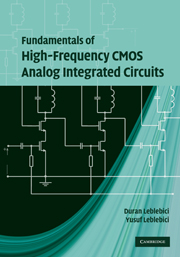Book contents
- Frontmatter
- Contents
- Preface
- 1 Components of analog CMOS ICs
- 2 Basic MOS amplifiers: DC and low-frequency behavior
- 3 High-frequency behavior of basic amplifiers
- 4 Frequency-selective RF circuits
- 5 L-C oscillators
- 6 Analog–digital interface and system-level design considerations
- Appendix A Mobility degradation due to the transversal field
- Appendix B Characteristic curves and parameters of AMS 0.35 micron NMOS and PMOS transistors
- Appendix C BSIM3-v3 parameters of AMS 0.35 micron NMOS and PMOS transistors
- Appendix D Current sources and current mirrors
- References
- Index
6 - Analog–digital interface and system-level design considerations
Published online by Cambridge University Press: 05 June 2012
- Frontmatter
- Contents
- Preface
- 1 Components of analog CMOS ICs
- 2 Basic MOS amplifiers: DC and low-frequency behavior
- 3 High-frequency behavior of basic amplifiers
- 4 Frequency-selective RF circuits
- 5 L-C oscillators
- 6 Analog–digital interface and system-level design considerations
- Appendix A Mobility degradation due to the transversal field
- Appendix B Characteristic curves and parameters of AMS 0.35 micron NMOS and PMOS transistors
- Appendix C BSIM3-v3 parameters of AMS 0.35 micron NMOS and PMOS transistors
- Appendix D Current sources and current mirrors
- References
- Index
Summary
In the earlier chapters of this book, we have introduced and examined the structure and operation of fundamental building blocks, or essential components, of high-frequency integrated circuits. The emphasis has been on transistor-level operation, the influence of device characteristics and parasitic effects, as well as the input–output behavior in time and frequency domains – with the intention to fill the gap between fundamental electronic circuits textbooks and more advanced RF IC design textbooks that mainly focus on the state-of-the-art. In this chapter, we will address a different domain and consider various aspects of “bringing together an entire system”, especially for interfacing high-frequency analog components with corresponding digital processing blocks, using data converters. Instead of considering specific system architectures, the main aspects of system design will be presented with a generic approach in the following, as much as possible. The main philosophy is very similar to that of the earlier chapters: discussing design-oriented strategies and drawing attention to key issues that must be taken into account when combining analog and digital building blocks. For a detailed discussion of the system components and their circuit-level realizations, the reader is advised to consult any one of the excellent texts that already exist in this domain.
General observations
The vast majority of integrated systems used in communication applications today consist of analog as well as digital building blocks, combined within one package in close proximity to each other, or fabricated on a single chip substrate.
Information
- Type
- Chapter
- Information
- Fundamentals of High-Frequency CMOS Analog Integrated Circuits , pp. 259 - 276Publisher: Cambridge University PressPrint publication year: 2009
